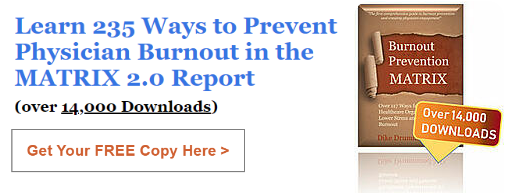Protecting the Front Line When You Are Not the Boss
These questions work like magic because they force administrators to think about the human cost of their decisions without being confrontational.
Simple, open ended question that interrupt the usual rush to maximize profits and remind everyone to think about the people implications of every decision.
In this blog post, I'll show you two power questions that can safeguard the health and well-being of your colleagues in the front lines—especially if you are often the only doctor in the room in senior leadership meetings.
When you became a leader, I know you didn’t go over to the dark side. You’re not Darth Vader. These questions confirm your position as a guardian and protector of the front-line doctors and nurses every time you use them.
Add them to your wellness leadership toolkit and get ready to use them early and often.
~~~~~~~~~~~~
Physician Leaders
You didn't go over to the dark side
and you are way more than just another bean counter
My physician leadership performance coaching practice has 3 openings
Become a More Effective, Respected and Influential Physician Leader
CLICK to Book your Discovery Session Now
~~~~~~~~~~~~
From the Triple Aim to the Quadruple Aim
To understand these questions, we have to go back to 2008, when the Institute for Healthcare Improvement (IHI) call the healthcare industry to task for the enormous expense and the disgraceful quality of Healthcare in America. Basically we spend three times more than any other country per capita on Healthcare and have the worst population health statistics in the First World by a long shot.
So the IHI developed a thing they called the Triple Aim, recommending all Healthcare leaders maintain a focus on three factors:
Cost
Quality
Population health
Pause for just a second here. Can you see what's missing from this list of priorities? That incomplete list instantly exposes the massive blind spot in American Healthcare. Here are the consequences.
Turns out the IHI is pretty good at promulgating standards and across Healthcare these three principles were adopted.
It also turns out that if all you focus on is cost, quality and population health the most reliable effect is BURNOUT in the folks in the front lines - our physician nurse colleagues.
A paper published in 2014 in the Annals of Family Medicine by Bodenheimer and Sinsky introduced the Quadruple Aim, adding a fourth pillar: the health and well-being of the people providing care.
Without this fourth aim, the first three will eventually destroy the care team.
Since the launch of the quadruple aim there's been a lot of lip service in healthcare about taking better care of the people. Yet burnout writes peaked in the 60% range during coven and are hovering at 50% now.
I consider the quadruple aim to be a failed concept. It's purely an intellectual construct that is not typically practiced by Healthcare leadership teams. You weren't given tools to bring the Quaruple Aim to life in the leadership conversations that affect conditions on the front line.
I encourage you to incorporate these questions into your leadership toolkit
Question #1: The Daily Safeguard
So let me give you the first of two power questions. This one is your daily tool. Ask it in meetings, in project planning, in executive discussions—anytime a decision is on the table.
"What effect will this decision have on the health and well-being of our people?"
This is your moment to represent the Quadruple Aim. If improving cost, quality, or population health results in increased stress on your clinicians, then you’ve shot yourself in the foot. You must speak up.
And if it’s clear that a decision will increase stress levels or burnout risk, your next move is simple:
"How can we engineer the negative effect on well-being out of this decision?"
Can we do it in a new way?
Can we reduce the burden?
Can we eliminate the added stress altogether?
And are we willing to cancel the decision if we can't?
Burnout rates are averaging 50% across doctors and nurses on every shift. This is not a trivial concern. Be prepared—if you ask this question consistently, someone may say, “Why did we let you in this group?” You’re there to be the watchdog. Stay the course. And immediately respond by asking question two below.
Question #2: The Strategic Check-In
Question two is more global. It tests whether the organization actually values the well-being of its care team. I’ve asked this to hundreds of CEOs and CMOs over the years.
What role do you believe the health and well-being of your people plays in the quantity and quality of care that they provide?
The follow-up, when they inevitably say something like “Of course it matters,” is:
What is our proactive strategy to optimize the health and well-being of your people?
That’s where the truth comes out. Most organizations do nothing.
There’s no strategy.
No metrics.
Just empty words - and maybe an occasional burnout survey they do nothing about.
A Call to Wellness Leadership
Let’s review:
Question 1 (daily use): What effect will this decision have on the health and well-being of our people? If the effect is negative: How can we engineer it out?
Question 2 (strategic check): What role do you believe well-being plays in quality and quantity of care? Follow-up: What is your proactive strategy to support it?
In all the times I’ve asked these questions, no leader has denied the connection between well-being and performance. But almost none have had a plan—and none measured its effectiveness.
The state of wellness leadership in U.S. healthcare is abysmal. If you're ready to explore what a proactive wellness strategy looks like in your organization, grab a discovery session with me so I can show you a four-part Wellness Strategy we call the QUADRUPLE AIM BLUEPRINT
~~~~~~~~~~
PLEASE LEAVE A COMMENT
Does your organization understand and protect position well being?
Please ask this question and come back and tell us how it went!

